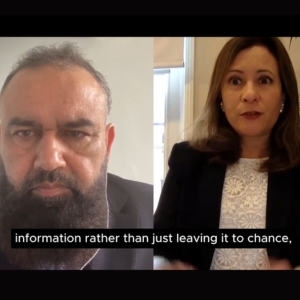Malikshaw Interim
Level Playing Field

I recently had the pleasure of meeting Shirley Cooper OBE—Crown Representative. Our conversation was both insightful and inspiring, touching on the challenges that SMEs face when supplying government departments. Shirley’s deep understanding of public sector procurement and her advocacy for greater SME inclusion made for a valuable discussion. It was refreshing to engage with someone who not only recognises these challenges but is actively working to improve access and opportunity for SMEs.
From navigating complex frameworks to ensuring cash flow resilience amid long procurement cycles, the hurdles facing SMEs in this space are significant. However, with the right structures and policies in place, these challenges can be mitigated. Our discussion reaffirmed the need for ongoing collaboration between government bodies and SMEs to foster innovation, agility, and efficiency in public procurement.
The introduction of The Procurement Act 2023 marks a big shift in how procurement is managed across government and the wider public sector. While the ambition to create a more transparent, accessible, and competitive landscape is commendable, the real test will be in how it plays out in practice.
For SMEs, the Act brings both opportunities and uncertainties. On the one hand, there’s a push to simplify procurement and cut unnecessary complexity, which should make things easier for smaller businesses to compete. On the other, adapting to new rules, compliance measures, and the inevitable early-stage issues could be tricky.
A key question is whether the Act will genuinely level the playing field or whether established procurement practices will continue to favour larger players. SMEs bring innovation, flexibility, and efficiency—qualities that are vital for public sector transformation. If the Act can genuinely break down barriers and make competition fairer, the benefits could be huge.
At Malikshaw, we’ve worked with many major government bodies like Homes England, the Office for National Statistics (ONS), and the Cabinet Office. These partnerships have shown us just how important SMEs are in delivering value to the public sector. Across all these organisations, a common theme has emerged—SMEs play a vital role in fostering agility, driving innovation, and bringing fresh perspectives to complex challenges.
Take our Transformation Trailblazers programme, for example. Pretty much every major consultancy agrees—around 70% of transformations fail to meet their objectives. And the number one reason they give? Poor leadership.
Now, the big four consultancies, who are often the government’s go-to for advice, naturally promote their own people rather than looking to independent expertise. But here’s the thing: the real game-changers—the people who’ve actually delivered the most successful transformations—often sit outside those firms. And by default, that means government could be shutting itself off from the very talent that could turn this statistic around.
Of course, levelling the playing field is a shared responsibility across all kinds of organisations. But a programme like Transformation Trailblazers, which gives government direct access to the most proven and successful transformation leaders, is invaluable. And the reality is, that kind of access only truly comes through SMEs like Malikshaw.
Whether it’s supporting infrastructure projects, enabling digital transformation, or contributing to procurement reform, smaller businesses are consistently demonstrating their ability to deliver tailored, effective solutions that larger firms often struggle to provide. The government’s commitment to increasing SME participation is promising but making procurement frameworks genuinely accessible and ensuring this flows throughout the supply chain, will be crucial to success. A point that clearly resonated with Shirley.
Looking back on our experiences, it’s clear that SMEs aren’t just suppliers—they’re crucial partners in public sector transformation. Our ability to build strong teams, move quickly, and bring fresh perspectives makes us invaluable to government projects.
At Malikshaw, we don’t just deliver projects. We help drive transformation—whether that’s through digital solutions, policy support, or strategic change. We build resilient teams, encourage innovation, and make sure public sector initiatives achieve real results.
The procurement landscape is changing, and while there are challenges ahead, there are also plenty of opportunities. The Procurement Act 2023 is a step in the right direction, but its impact will partially depend on how well government departments embrace the potential of SMEs. With continued collaboration, strong advocacy, and a focus on delivering real value, we can help shape a procurement system that genuinely supports innovation and efficiency.
I’m looking forward to seeing how this develops and will keep sharing insights as we navigate this evolving space.
Rob Shaw
Director
Malikshaw Podcasts: Transformation Trailblazers
Diverse Teams: Better Teams

Ever sat in a meeting where everyone pretty much thinks the same way, nods along, and comes up with the same safe ideas? It’s comfortable, sure, but it’s also a recipe for mediocrity. The best teams—the ones that innovate, solve tricky problems, and push industries forward—are the ones made up of people from different backgrounds, experiences, and ways of thinking. And when it comes to tech, diversity isn’t just a nice-to-have, it’s a proven driver of success.
We know this because the research is crystal clear: diverse teams deliver better results. A McKinsey study found that companies with gender-diverse leadership teams are 25% more likely to be more profitable than their competitors. But despite this, women—and other underrepresented groups—are still battling to get a fair shot in tech. That’s why so many businesses and public sector organisations in the UK are finally putting serious effort into EDI (Equality, Diversity, and Inclusion) initiatives. These aren’t just corporate buzzwords; they’re now a vital part of the armoury for any company that wants to stay competitive, innovative, and, let’s be honest, relevant.
Take the UK Government Digital Service (GDS), for example. They’ve made a real push to build gender-diverse teams, not just by hiring more women but by creating an environment where diverse talent can actually thrive. It’s one thing to recruit inclusively; it’s another to make sure people feel valued, supported, and able to progress. GDS has nailed this by championing female leaders, offering strong career pathways, and embedding diversity into their hiring from the ground up. And guess what? It’s working.
The private sector has been making strides too. Salesforce, for instance, has taken gender diversity seriously, with equal pay policies and clear targets for getting more women into technical roles. IBM, a heavyweight in the UK tech scene, has doubled down on mentorship and leadership programmes to ensure women not only enter the industry but stay and succeed. These aren’t just good PR moves—they’re smart business decisions that lead to stronger teams and better outcomes.
Organisations like Code First Girls, Women in Tech, and Her Tech Talent are also stepping up to change the game. Code First Girls has trained thousands of women in coding and digital skills, opening doors to careers in tech for those who didn’t take the traditional computer science route. Women in Tech is spotlighting success stories and making sure companies stay accountable for their diversity promises. And Her Tech Talent is creating pathways for women to access leadership roles in the industry, helping businesses connect with diverse talent at every level. These initiatives are proving that when businesses invest in real inclusion, the whole industry benefits.
So, what can future leaders learn from all this? The women who’ve carved out successful careers in tech often point to the same things: mentorship, resilience, and strong support networks. Having people in your corner who believe in you can make all the difference. And for companies, it’s about building teams where everyone—regardless of gender, background, or experience—has a voice and a fair shot at success.
At the end of the day, diversity isn’t a box-ticking exercise—it’s what makes teams stronger, businesses more successful, and innovation possible. The UK tech sector has come a long way, but there’s still plenty of work to do. The best teams aren’t the ones where everyone looks, thinks, and works the same. They’re the ones that challenge, inspire, and bring out the best in each other. That’s why independent specialist recruiters like Malikshaw Interim & Executive are so important—helping businesses find and develop diverse leadership talent and ensuring they’re part of the solution, not just talking about it. Because in the end, real progress happens when inclusion isn’t just a goal, but the way we do business.
Building Purpose-Driven Teams

In recent years, the expectations of candidates have changed in ways that organisations can’t afford to ignore. It’s no longer just about the salary – although that still matters, of course – today’s candidates are looking for something more meaningful from their employers. Career development, a sense of purpose, and alignment with personal values are increasingly high on the agenda. The best candidates want to feel that their work fits into the bigger picture, and that they’re contributing to something that matters. If companies fail to meet these expectations, they risk missing out on top talent.
Take Kate, for example. Kate is a project manager with a strong sense of personal values. Whether she’s choosing a brand of toothpaste, deciding which charity to support, or considering a new job, she always looks for consistency. Her decisions, big or small, are driven by what feels right to her, and she prefers to work for companies that reflect those values. For Kate, it’s not just about a pay packet – she wants to work for a business that shares her commitment to sustainability, ethical practices, and giving back to the community. If those values align with the company’s mission, she’s far more likely to feel motivated and engaged. If they don’t, she’ll soon start looking for something that does.
This shift in expectations has big implications for companies, especially those managing transformation projects. A good project manager today must do more than just ensure the project meets deadlines and stays on budget. They also need to connect with their team on a deeper level. Building a successful transformation leadership team isn’t just about getting the technical details right – it has to incorporate the bigger picture. A skilled project manager will take the time to understand what motivates each team member, ensuring that they feel a sense of purpose in the work they’re doing. When team members feel that their work is meaningful and that the company shares their values, they are more likely to embrace the changes being implemented and put in the effort needed to make the transformation a success.
The best project invest time and energy into communicating clearly, building trust, and involving their team in the decision-making process. They know that when team members feel valued and aligned with the company’s mission, they’ll not only support the change – they’ll champion it. It’s about creating an environment where people feel motivated, supported, and excited about the future.
This is where a specialist recruiter like Malikshaw Interim and Executive can make all the difference. At Malikshaw, we don’t just look at a candidate’s skills on paper. We take the time to get to know candidates on a deeper level – what their values are, what motivates them, and what kind of company culture they thrive in. It’s about making sure there’s a real fit, not just on paper, but in terms of personality, values, and aspirations. When companies work with us, they get more than just a list of qualifications – they get the right person who’s going to be engaged, motivated, and committed for the long term.
The world of recruitment has evolved, and today’s candidates are more discerning than ever. They’re looking for employers who offer more than just a salary – they want purpose, alignment with their values, and opportunities to grow. At Malikshaw, we understand this, and we take pride in matching candidates who are the right fit – not just for the job, but for the culture and mission of the business. When that connection is made, it’s not just good for business; it’s good for everyone involved.
Balancing Stability and Flexibility

The world of work has changed a lot in recent years, and uncertainty is something many of us are dealing with. Whether it’s the public sector, the private sector, or any other industry, it’s clear that work isn’t as predictable or stable as it used to be.
Take Aamir, for example. He’s a project manager in a local council, overseeing a large infrastructure project. Halfway through, the government announces funding cuts, and suddenly his team is told to scale back the project. Now, Aamir has to rethink his role, his team’s goals, and maybe even his whole career. The uncertainty surrounding his job makes him wonder whether to stay in a long-term position or look for something more flexible.
Aamir’s story is pretty common these days. Public and private sector employers are facing similar challenges, whether that’s due to changing government policies, market fluctuations, global influences, or new business regulations. With so many factors influencing the way organisations operate, it’s no wonder that workers often feel like their future is up in the air.
In this environment, many people are turning to short-term, flexible roles as a way to manage the uncertainty. These opportunities let you work on a range of projects with different teams, without being tied to one long-term commitment. For someone like Aamir, who’s used to shifting between projects, these types of roles can be very appealing. They offer more control over your schedule, often pay better, and allow you to gain a diverse range of experiences, all without being locked into a permanent job.
But of course, there are also clear benefits to long-term roles, especially for those who value job security and career growth. Staying in one role for an extended period can offer the chance to build deeper relationships, gain expert knowledge, and progress through the ranks. For those who seek stability, job security is often a key factor in deciding whether to stay in a long-term role.
The trend towards more flexible career paths – jumping from one job to another instead of staying in one for decades – has made things more challenging for recruiters. They now need to find candidates who can commit to long-term projects, while also managing the growing demand for short-term contracts. This can be tricky, as different people have different expectations. Some are looking for the stability that comes with permanent positions, while others want the variety and flexibility that comes with contract work. Recruiters have to be able to understand these preferences and match candidates with the right roles while balancing the needs of employers.
For candidates, this shift in the way we work can feel both exciting and a little daunting. On the one hand, short-term roles can offer variety and a chance to try new things, but they also come with the uncertainty of not knowing what comes next. Meanwhile, long-term roles can offer security, but they might feel like they limit your options or slow down career growth. Finding the right balance between stability and flexibility is a highly personal decision.
As work continues to evolve, whatever the sector, all organisations need to be more creative and nimbler. They need people who can adapt quickly and handle change, but workers also need to decide what type of role suits their needs best. This is where a specialist recruitment partner like Malikshaw Interim and Executive can really make a difference. With our deep knowledge of the recruitment landscape, we’re in a great position to help businesses and candidates navigate the challenges of today’s workforce. By understanding both the challenges employers face and the needs of candidates, we’re able to guide everyone through the decision-making process, helping them find the right fit – whether that’s a flexible role or a long-term career path.
Leadership Teams: Avoiding the Revolving Door Trap

When thinking about managing a transformation project it’s easy to focus on the start – the early excitement of getting the right people in place and setting goals. But the real test comes when the project moves from its planning phase into full execution, and the long road ahead starts to take its toll. Keeping the right people in place is absolutely crucial if you want to ensure the project’s success, and that’s where retention becomes a game-changer.
Imagine this scenario: your project has been going smoothly. The right team, a sound strategy, and the momentum is building. But then, out of nowhere, you lose a key player. It could be the project manager, a lead engineer, or a business analyst – someone integral to the day-to-day operations of the transformation. The ripple effect is instant. What happens next? You lose continuity, you lose expertise, and the project has to be recalibrated. Even worse, the new person who steps in won’t be able to get up to speed immediately. They need time to understand the project’s history, the relationships, and the nuances of the work already completed. If this happens too many times, the project starts to drift. And believe us, we’ve all seen it before: the ‘revolving door’ of leaders who come and go. By the time you’re on your third or fourth project lead, the team’s energy is sapped, and the goalposts have shifted.
The challenge of retaining key members is particularly difficult in transformation projects because of their complexity and long durations. These projects are often a marathon, not a sprint. They evolve as they progress, and this means the team’s skill sets need to evolve too. At the beginning, your project might be heavy on strategists and senior planners. But as the work moves into execution, you’ll need more technical experts, data scientists, or change managers to meet the new challenges that arise. In this dynamic environment, people need to be brought in at the right time. This is where extension comes in – you might need to extend contracts, bring in new talent, or adjust the team’s composition to suit the project’s changing needs. And yet, it’s all too common for businesses to forget about the importance of retaining the right people through this phase. When you lose key players, you risk the project spiralling into delays, frustration, and additional costs that could have been avoided.
Getting the right leadership in place is no easy task. It’s a challenge to find someone who not only fits the technical requirements but can also gel with the team and understand the wider vision of the project. But it’s an investment worth making. If you’ve managed to secure the right leader, the one with the vision, communication skills, and technical expertise to carry the project through its lifecycle, then you’ve got something valuable. These leaders don’t just steer the ship; they keep the team motivated, help resolve issues when they crop up, and keep everything aligned with the broader strategic goals.
That’s where interims can be worth their weight. If a transformation project has stalled, lacks some of its initial direction or momentum, or perhaps the team needs a fresh perspective to break through the impasse, bringing in interim leadership at this point can be a breath of fresh air. They bring with them a wealth of experience, not just from the industry but from other transformation projects they’ve led. They offer that critical outsider’s view, which can help reframe the project and get it back on track. Of course, it’s essential to find the right interim – someone who can integrate with the existing team and hit the ground running without causing disruption. Specialist recruiters can provide tailored support at this stage. They’re the ones with access to those hard-to-find candidates, the ones who are ideally suited to step into a project that’s at a crossroads and take it forward. They have the network and the expertise to source talent that isn’t just available but is also the perfect fit for the unique requirements of your project.
Ultimately, transformation projects are complex, and there’s no one-size-fits-all solution. But understanding the importance of retention, extension, and bringing in the right leadership at the right time, can mean teams stay strong, projects stay on track, and the results are worth the investment. The key is balance. And when the going gets tough, remember that the right leader, backed by the right support, can turn things around – just don’t let the revolving door catch you out!
If you’re in need of specialised recruitment support, Malikshaw Interim & Executive have a wealth of experience in sourcing candidates who can step into critical roles and make an immediate impact. They’ve built a strong reputation for connecting businesses with top-tier leadership talent that can help transform projects and drive them to successful completion.
Have you experienced good practice in managing talent through a transformation project? Or perhaps you’ve faced challenges with retention and leadership changes? We’d love to hear your insights and experiences – feel free to share them with us!
True Transformation: A Personal Take on Big Change

Here’s something that’s caught my eye recently: a government organisation putting out the call for 50 new team members to tackle a major transformation programme. Fifty! That’s not just scaling up—that’s gearing up for something truly ambitious. And it’s not an isolated example. Look at the recent Devolution White Paper. It’s been described as a root-and-branch overhaul of how power and responsibility flow between central government and the regions. Sure, we don’t know all the details yet, but it’s clear this is part of a bigger movement. Then there’s the Ministry of Defence’s recent announcement of a review—another sign of just how broad and deep these transformations are getting.
These aren’t just tweaks to existing systems; they’re whole new ways of thinking. They’re about stepping back, looking at the big picture, and reshaping how things work from the ground up. It’s exciting, isn’t it? But let’s talk about what this really means for the people side of the equation.
When I think about these changes, one thing stands out: the sheer scale of the recruitment and skills challenge. This isn’t just about filling roles; it’s about building teams that can handle complexity, uncertainty, and rapid change. It’s a wake-up call for organisations to rethink how they attract, develop, and retain talent.
Here’s where I see the biggest shifts happening:
- Versatility is the New Standard: These transformations demand people who can work across disciplines, adapt to new challenges, and see connections others might miss. It’s not just about deep expertise anymore; it’s about breadth and flexibility.
- Upskilling is Non-Negotiable: To stay ahead, organisations need to invest in their people. Upskilling isn’t just a nice-to-have—it’s essential for creating teams that can innovate and collaborate effectively.
- Leadership Needs a Rethink: Today’s leaders need to be more than decision-makers. They need to be connectors, facilitators, and enablers of collaboration. The Defence Review Team is a great example of how this kind of leadership can work in practice.
If sectors like defence and governance are leading the charge, it’s only a matter of time before others follow. Energy and Water, for example, are crying out for similar comprehensive reviews. With the pressure to deliver sustainable, future-proof systems, they’re prime candidates for this kind of root-and-branch transformation.
It follows therefore that the latest news coming out of Whitehall is that Prime Minister Sir Keir Starmer, the chancellor and business secretary have written to the UK's main regulators asking them to come up with ideas for reform that could boost economic growth.
They contacted watchdogs, including energy regulator Ofgem and water regulator Ofwat, before Christmas asking them to submit proposals by mid-January. This comes after figures just published indicated the UK economy had flatlined between July and September.
This letter is evidence that the government wants to pull every possible governmental lever to make sure arms-length bodies like regulators such as Ofgem, as well as government departments, prioritise helping deliver Labour's mission of achieving the highest sustained economic growth in the G7.
It is also an indication that the prime minister fears regulators can restrain economic growth by imposing obstacles to business activity – a message typically more associated with Conservative politicians but which Starmer is increasingly putting at the heart of his plans.
So, it seems that transformation will sit at the heart of our country’s economic growth. Or, it will do if we can be brave and bold enough to back this up with the right levels of investment. We’ll see.
At Malikshaw, we’ve always believed that true transformation starts with the right blueprint. It’s about understanding the big picture, yes, but also making sure every piece fits together to deliver long-term success. That’s why we work hard to match the right talent to the right challenge. We know that building the right team isn’t just a task—it’s the foundation of everything else.
If you’re grappling with a major transformation, we’re here to help. Whether it’s finding the leaders to drive change or the specialists to make it happen, we’ve got the network and the expertise to support you every step of the way.
Want to Dig Deeper?
We’ve put together a detailed report on the Devolution White Paper and what it could mean for organisations like yours. It’s full of insights into these reforms and practical advice on how to prepare for what’s coming next. Let us know if you’d like a copy—we’d be happy to share.
True transformation isn’t just something you talk about. It’s something you do. And from where I’m standing, it’s happening all around us. Let’s make sure we’re ready to meet it head-on.
Big Change or Transformation

When it comes to major organisational change, one of the first questions you need to ask is: Is this just a big project, or are we looking at something more profound—a true transformation? The answer to that question can completely shift how you approach the work, the people you involve, and the ultimate success of the initiative.
Bob, a seasoned leader in transformation projects, sums this up perfectly with a brilliant analogy:
"If one thinks of your house, changing the plumbing is akin to an IT project, enhancing the wiring—process improvement, knocking two rooms into one—organisational change. But if you're turning a garage and part of a room into something completely new, like a kitchen—ALL of those things would need to be done together for it to be a transformation programme."
It’s easy to think of any large project as a transformation. But the distinction is crucial.
A big project might involve upgrading existing IT systems or improving specific processes. These are critical to keeping things running smoothly, but the fundamental structure of your organisation stays the same. You’re changing the plumbing, rewiring the house—but you’re not changing the layout or purpose of the rooms.
A root-and-branch transformation, however, is about rethinking and reworking everything. It’s a complete overhaul. In Bob’s analogy, it’s turning a garage into a fully functional kitchen. You’re tackling the plumbing, the wiring, and the walls, but also transforming the entire space to serve a different function. In organisational terms, this means redesigning processes, culture, systems, and people to work towards a completely new set of goals.
The first step is understanding exactly where you are. Are you dealing with an upgrade, or is this a full transformation? The distinction will shape how you plan and execute the project. Are you looking at a shift in how people work or a major cultural shift in the organisation? Will you be making technical improvements or also changing how your teams interact, collaborate, and serve your customers?
Understanding where you are in the process will help you identify the skills and leadership needed to get it right.
Especially in the public sector, there’s a real need for transformation—whether it’s due to digital reforms, policy changes, or restructuring efforts. With the new government rolling out its reforms, much of what’s ahead will require fundamental change. That’s not just about upgrading software or processes; it’s about transforming the very structure and purpose of public sector organisations.
This is where professional leadership comes in. Strong, experienced leadership can make all the difference between success and failure. Whether you’re upgrading systems or undergoing a full-scale transformation, the right leadership will help you:
- Keep the project on track
- Manage cross-functional teams effectively
- Overcome resistance to change
- Align the organisation with new strategic goals
Professional leaders bring the experience to guide the transformation smoothly, manage risks, and ensure the right skills are in place. Their expertise can flip the chances of failure into success, particularly when navigating complex changes.
At Malikshaw Interim & Executive, we believe that recognising whether you’re facing a big project or a root-and-branch transformation is key to getting it right. Understanding where you are in the process, bringing in the right leadership, and having a clear vision will make all the difference as you tackle these changes.
Especially with the fundamental changes coming down the line in the public sector, having experienced leaders who understand the landscape will be crucial. Are you ready to turn your project into a true transformation? Let’s talk about how we can help you make that happen.
Malikshaw's Commitment to Net Zero 2024
Carbon Reduction Plan
Commitment to achieving Net Zero
EVISA SOLUTIONS LTD is committed to achieving Net Zero emissions by 2030.
Baseline Emissions Footprint
Baseline emissions are a record of the greenhouse gases that have been produced in the past and were produced prior to the introduction of any strategies to reduce emissions. Baseline emissions are the reference point against which emissions reduction can be measured.
|
Baseline Year: 2022 |
|
|
Additional Details relating to the Baseline Emissions calculations. |
|
|
2022 is the Baseline for reporting purposes. |
|
|
Baseline year emissions: |
|
|
EMISSIONS |
TOTAL (tCO2e) |
|
Scope 1 |
0 |
|
Scope 2 |
55.236 |
|
Scope 3 (Included Sources) |
4.195 |
|
Total Emissions |
59.431 |
Current Emissions Reporting
|
Reporting Year: 2023 |
|
|
EMISSIONS |
TOTAL (tCO2e) |
|
Scope 1 |
0 |
|
Scope 2 |
47.066 |
|
Scope 3 (Included Sources) |
3.232 |
|
Total Emissions |
50.298 |
Emissions reduction targets
In order to continue our progress to achieving Net Zero, we have adopted the following carbon reduction targets. Using these projects we project that carbon emissions will decrease over the next five years to 43 tCO2e by 2027. This is a reduction of 27.65%
Carbon Reduction Projects
Completed Carbon Reduction Initiatives
The following environmental management measures and carbon reduction projects are being implemented to achieve this plan. These include fully electric company car fleet, changes in policy initiating a reduction in company travel, increased work from home and office energy efficiency measures regarding heating and lighting. The carbon emission reduction to be achieved by these schemes equate to 5 tCO2e, an 8.5% reduction against the 2022 baseline and the measures will be in effect when performing the contract
Declaration and Sign Off
This Carbon Reduction Plan has been completed in accordance with PPN 06/21 and associated guidance and reporting standard for Carbon Reduction Plans.
Emissions have been reported and recorded in accordance with the published reporting standard for Carbon Reduction Plans and the GHG Reporting Protocol corporate standard and uses the appropriate Government emission conversion factors for greenhouse gas company reporting.
Scope 1 and Scope 2 emissions have been reported in accordance with SECR requirements, and the required subset of Scope 3 emissions have been reported in accordance with the published reporting standard for Carbon Reduction Plans and the Corporate Value Chain (Scope 3) Standard.
This Carbon Reduction Plan has been reviewed and signed off by the board of directors (or equivalent management body).
Signed on behalf of the Supplier:
Date: 1st June 2024
Robert Shaw
Partner | Public Sector
Transformation in 2025: First Foot Forward!

Happy New Year, everyone! As we dive into 2025, the air is thick with anticipation. Change is always in the wind, but this year feels particularly pivotal, especially for organisations navigating complex landscapes. From public sector giants to nimble SMEs, the demand for transformation expertise has never been greater.
So, what’s shaping this urgency? On the global stage, economic uncertainty, climate commitments, and continued digital disruption are driving major shifts. Governments are grappling with how to implement AI policies effectively, businesses are adapting to stricter ESG standards, and tech advancements like quantum computing are starting to edge closer to reality.
Closer to home in the UK, we’re bracing for the ripple effects of policy changes, post-Brexit trade realities, and challenges like workforce shortages in critical sectors. Public sector organisations face rising demand for efficient, tech-driven services amidst budget constraints. SMEs, meanwhile, are battling to stay competitive in a market increasingly dominated by digital-first operations and agile competitors.
This landscape is fertile ground for transformation—but it’s not without its pitfalls. The organisations that thrive will be those that embrace change proactively rather than reactively. Here’s where a specialist transformation manager can tip the scales from just surviving to thriving.
Leading with Vision
Transformation managers bring more than just project management skills—they bring vision, strategy, and the ability to rally diverse teams. They’re the navigators who can help organisations weather uncertainty by:
- Future-proofing operations: Ensuring systems, processes, and teams are agile enough to adapt to fast-evolving challenges.
- Aligning goals with reality: Marrying long-term strategic objectives with the immediate, practical steps to achieve them.
- Building resilient teams: Creating cultures where change isn’t feared but embraced, and where every team member is empowered to contribute.
The public sector, for example, can benefit enormously from transformation managers who can streamline services, improve citizen engagement, and ensure compliance with new regulations. SMEs can lean on them to pivot quickly, access innovative technologies, and remain competitive in their niche markets.
But here’s the rub: finding the right leader is no easy task. That’s where partnering with a specialist recruiter comes in.
Building Teams, Building Futures
At Malikshaw Interim & Executive, we’re not just about filling roles—we’re about building partnerships that last. Our focus on transformation has allowed us to connect top-tier professionals with organisations looking to shape the future. As 2025 unfolds, we’re seeing a surge of interest in interim and executive roles that go beyond project delivery to true organisational leadership.
Whether you’re a public sector organisation looking to innovate, or an SME aiming to scale sustainably, we’ve got the expertise to help you find the right talent for your needs—not just for now, but for the long haul.
So, here’s to a year of proactive transformation, bold leadership, and the teams that make it all possible. If you’re ready to take the First Foot forward in 2025, let’s have a conversation.



















